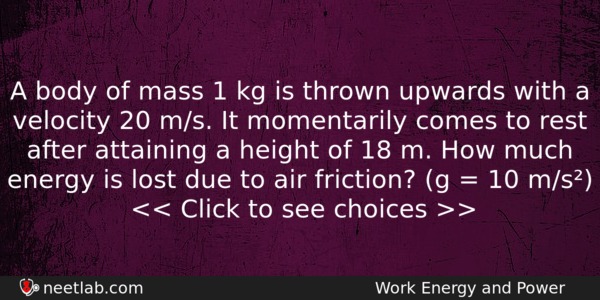| ⇦ | 
| ⇨ |
A body of mass 1 kg is thrown upwards with a velocity 20 m/s. It momentarily comes to rest after attaining a height of 18 m. How much energy is lost due to air friction? (g = 10 m/s²)
Options
(a) 30 J
(b) 40 J
(c) 10 J
(d) 20 J
Correct Answer:
20 J
Explanation:
When the body is thrown upwards. its K.E is converted into P.E. The loss of energy due to air friction is the difference of K.E and P.E
1/2 mv² – mgh = 1/2 x 1 x 400 – 1 x 18 x 10
= 200 – 180 = 20 J
Related Questions: - Four blocks of same mass connected by cords are pulled by a force F
- Sound production from tape recorder makes use of
- A body is rolling down an inclined plane.If KE of rotation is 40% of KE in a translatory
- A pure semiconductor behaves slightly as a conductor at
- The ratio of the nuclear radii of elements with mass numbers 216 and 125 is
Topics: Work Energy and Power
(94)
Subject: Physics
(2479)
Important MCQs Based on Medical Entrance Examinations To Improve Your NEET Score
- Four blocks of same mass connected by cords are pulled by a force F
- Sound production from tape recorder makes use of
- A body is rolling down an inclined plane.If KE of rotation is 40% of KE in a translatory
- A pure semiconductor behaves slightly as a conductor at
- The ratio of the nuclear radii of elements with mass numbers 216 and 125 is
Topics: Work Energy and Power (94)
Subject: Physics (2479)
Important MCQs Based on Medical Entrance Examinations To Improve Your NEET Score
18000+ students are using NEETLab to improve their score. What about you?
Solve Previous Year MCQs, Mock Tests, Topicwise Practice Tests, Identify Weak Topics, Formula Flash cards and much more is available in NEETLab Android App to improve your NEET score.
Share this page with your friends

Leave a Reply